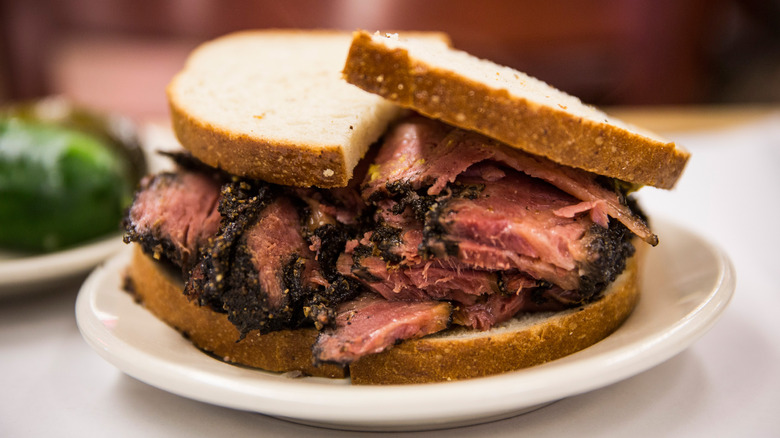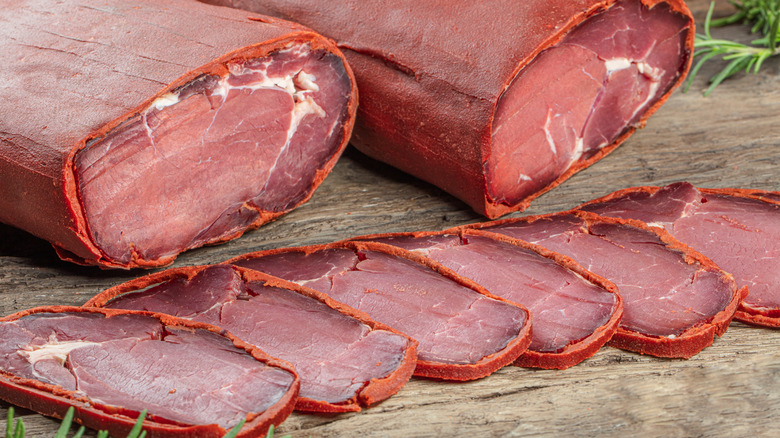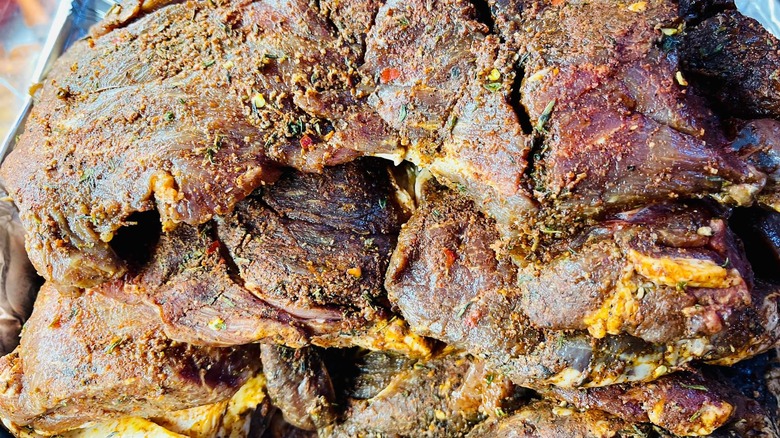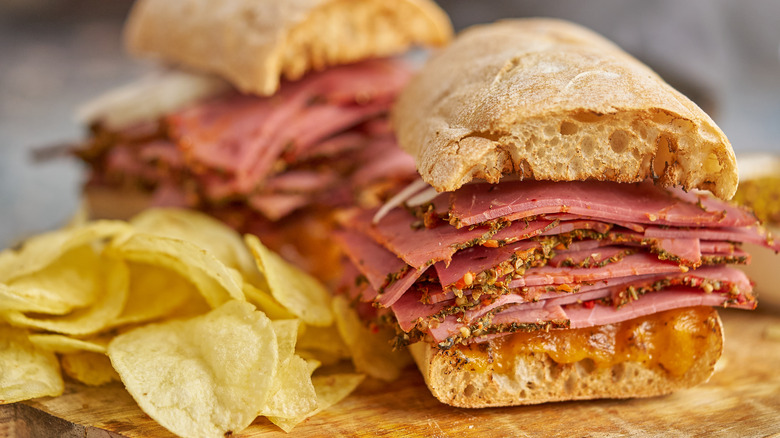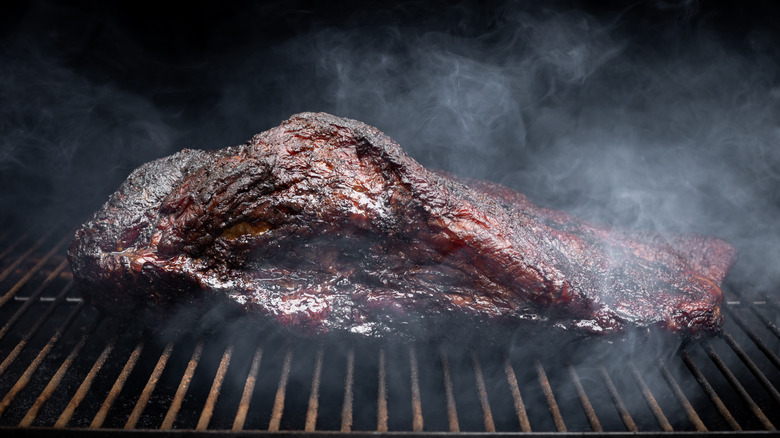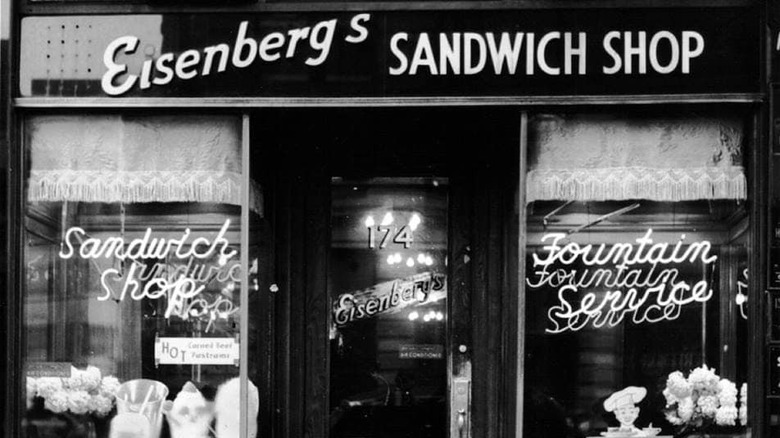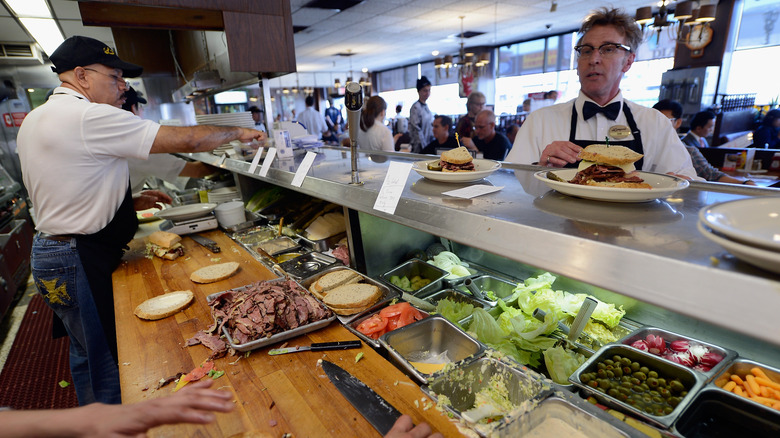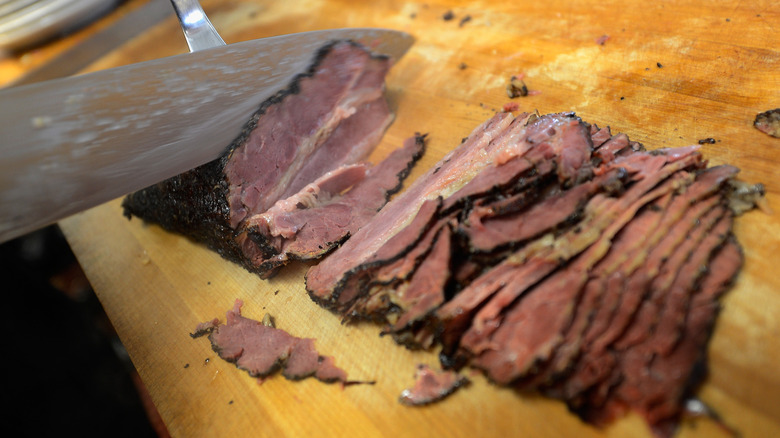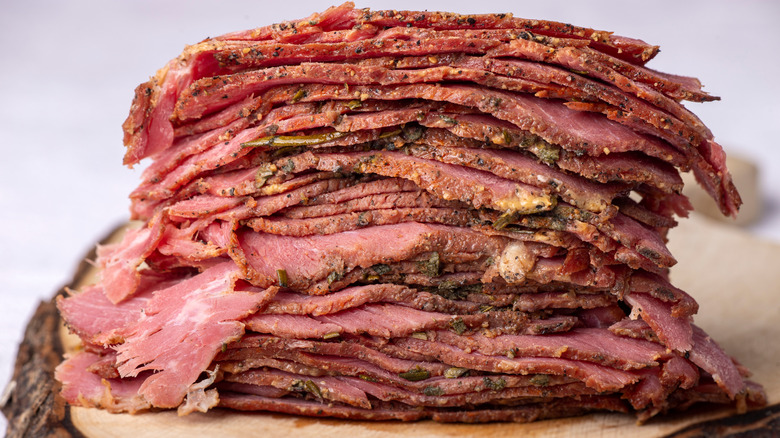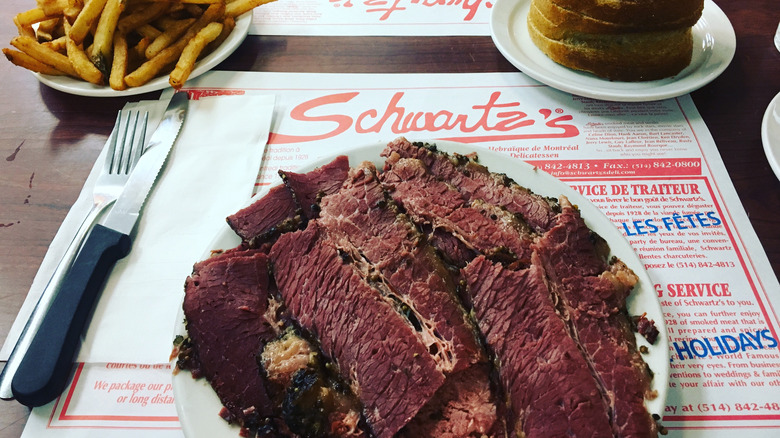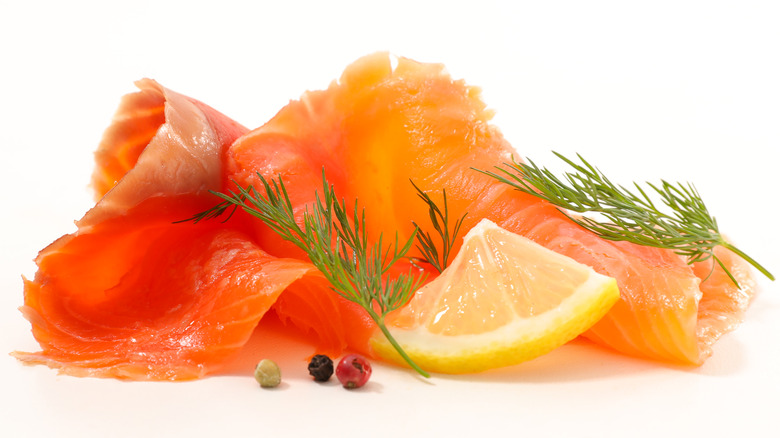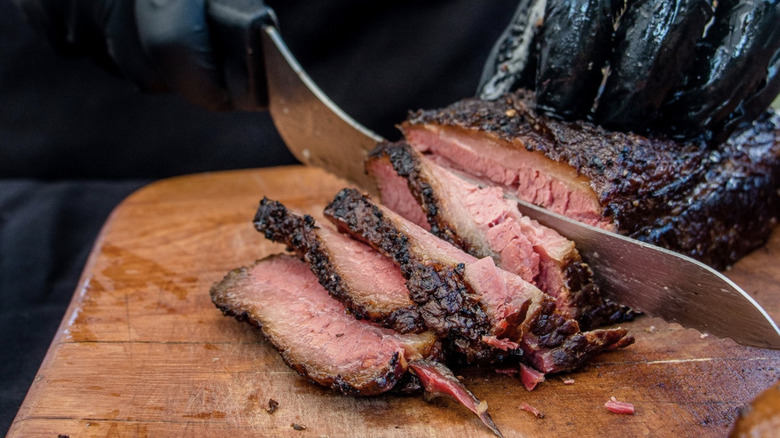The Untold Truth Of Pastrami
You can get something labeled pastrami from just about every supermarket deli counter in North America these days, but the sad slices of pink cured beef you'll find in most big box stores pales in comparison to the real stuff. If you've ever been to a deli that cures and smokes its own pastrami in-house, you know what we're talking about. Proper pastrami served hot from the steam table and cut by hand is almost obscenely decadent, slicked with fat, suffused with a smoky flavor, and coated with a spicy black seasoning blend. When the juice soaks through the two pieces of rye bread that are woefully inadequate to contain the enormous pile of meat within, you know you're eating a truly great pastrami sandwich.
But how did this crowning achievement in beef cookery begin? Well, it turns out that nobody seems to agree on that point. We've sifted through various accounts of this dish's history to give you the untold truth of pastrami, as best as we can determine. We hope we don't offend too many pastrami partisans along the way.
Pastrami descends from Turkish basturma
One possible antecedent to modern pastrami is basturma, also known as pastirma. According to StarChefs, this ancient pastrami progenitor comes from Turkey and it's quite different from modern versions. It's not cooked or smoked and it's more similar to jerky than something you would eat on a sandwich.
According to Al-Monitor, the process for making real basturma is complex. First, workers cut holes into high-quality pieces of beef, inserting large chunks of salt. After the salt cure, the beef is rinsed and then dried. It's next weighted down to press out excess moisture, then hung to air-dry. If the weather allows, the best results come from hanging it outside, and there's even a Turkish phrase — basturma summer — that describes the ideal conditions required. Finally, producers paint the basturma with a mix of oil, garlic, paprika, and other spices, then hang it to air-dry again. Although the traditional method is labor-intensive, the reward is a complex, flavorful dried meat that is an integral part of many traditional Turkish dishes.
Romanians turned basturma into pastrama (or perhaps it was the other way around)
The more direct ancestor of American pastrami is Romanian pastrama. According to Harry Levine's essay "Pastrami Land," this method for curing meat comes from regions of Europe that were once ruled by Turkey, including Romania. While this might mean that the Turks taught people in Romania how to make a version of basturma, it's also possible that Romanians were making their own air-dried meat long before the country was conquered by Turkey. As Al-Monitor notes, many different cultures can make a case for inventing this method of preserving meat.
The Slow Food Foundation notes that the word pastrama is derived from the Romanian word meaning to preserve, which may mean that it's a local innovation rather than a variation on basturma. Whatever the true origin may be, pastrama and basturma are very similar as they're both jerky-like meats made by drying beef (or in pastrama's case, usually mutton) coated in oil and spices in the open air. However, unlike basturma which is never smoked, pastrama is sometimes cold-smoked over an oak fire. This smoking step is also what makes American pastrami different from regular corned beef, according to "Pastrami Land."
Pastrami evolved from a jerky-like product into the deli meat we love today in New York
According to Serious Eats, deli culture in New York began in the 1800s with German immigrants. These entrepreneurs opened shops to sell a variety of cured meats, pickles, sausages, and other foods they remembered from the old country. After the 1870s, Jewish migrants from Eastern Europe and Romania started arriving in the city in large numbers, bringing local delicacies to the U.S. The Jewish newcomers opened their own delis, which were modeled after the older German shops but sold kosher specialties.
This is when pastrama landed in America, but it's not clear exactly how or why it transformed from the dried meat eaten in Romania to the softer brined, smoked version we know today. Although Katz's Deli and Sussman Volk have both been credited with inventing the American version of pastrami, they both came onto the scene after other butchers were already selling this kind of meat. Whoever came up with the idea first, it's clear that by the turn of the 20th century, kosher butchers in New York were making cured beef with an assertive black pepper rub that modern eaters would recognize as pastrami. While production was centered in New York, by this time, pastrami was also being shipped to Jewish delis in cities across the U.S. as well.
There's an alternative theory that modern pastrami was invented in Texas
Although the New York origin story of pastrami is the most widely accepted, there's an alternative theory that American pastrami was developed in Texas first (via Serious Eats). Since pastrami is made from smoked brisket and is thus somewhat similar to Texas barbecue brisket, the theory seems plausible on its face. This pastrami origin story first showed up in Robert Sietsema's "New York in a Dozen Dishes" and was also advanced by Eater's meat specialist, Nick Solares, in a video interview he did with Daniel Vaughn, Texas Monthly's barbecue editor.
Daniel Vaughn did a deep dive into the history of pastrami in Texas and found that it's been around in the state for a long time (via Texas Monthly). However, the earliest print reference to pastrami (spelled pastromie) in a Texas source is from 1916, and we know from Serious Eats that New York meatpackers were shipping pastrami all over the U.S. by then. So while it's fun to think that pastrami started as an offshoot of barbecue, the theory doesn't stand up to close scrutiny.
Large meatpacking firms (and maybe murder) helped spread pastrami across the country
Serious Eats highlights two companies that shipped pastrami nationwide during the late 1800s and early 1900s: New York's Moses Zimmerman and Chicago's David Berg. Both companies were founded by Jewish immigrants from Germany, and both produced salami, hot dogs, sausages, and other cured meats on an industrial scale. Zimmerman sent his wares as far afield as Santa Fe, New Mexico, and there's written evidence Berg's meats ended up in a deli in New Orleans, among many other places. David Berg & Co. was eventually folded into Chicago's Vienna Beef empire.
Pastrami was just one of the many cured meats these firms sold, and it might have remained in a minor role if not for a surge of popularity indirectly caused by a vicious crime. In 1897 prominent Chicago sausage seller Adolph Louis Luetgert murdered his wife, making national news. According to a news report from the time, the horrifying crime gave sausage a bad name and turned customers off the tubular meats. Pastrami's reputation, however, remained unsullied, and meat shop patrons began buying it instead of sausage.
Pastrami is an important part of Jewish-American identity
Although preserved meats, pickles, and other fare we associate with Jewish delis all have their roots in Eastern European culinary traditions, pastrami and the Jewish deli itself are both American innovations. Reviews of the book "Pastrami on Rye: An Overstuffed History of the Jewish Deli" in Forward and Haaretz explore how delis helped American Jews both define themselves as a community and assimilate into broader U.S. culture.
Delicatessens were already popular in America by the time Jewish immigrants began opening their own versions. While they sold foods that descended from dishes immigrants remembered eating in their home countries, delis also symbolized a very American sense of abundance and decadence. Back in Eastern Europe, most people couldn't dream of being able to regularly eat enormous piles of beef on a sandwich, but in America many Jews were able to enjoy a certain level of financial comfort and the pleasures that go along with it. As Jews became more integrated into American society, delis followed, ditching kosher butchers for cheaper conventional meat and marketing Jewish foods to those outside the faith. In modern times, with a decrease in popularity and cultural importance, the traditional delis that remain are a vital window into the history of American Jewish cuisine, with pastrami acting as a throughline that connects generations of happy eaters.
Katz's Deli is a pastrami mecca
Although Katz's may not have invented pastrami, the deli has been selling it to satisfied customers in Manhattan's Lower East Side for over a century. It has been operating under the Katz's name since 1910, witnessing the neighborhood change from an insular Yiddish-speaking enclave into the bustling, diverse district it is today (via Tenement Museum). In the early days, the deli functioned as an unofficial town square for the Lower East Side, serving up pots of beanie weenie to large crowds of people every Friday night.
These days, Katz's still makes its pastrami the same way it's been doing for decades. Per Serious Eats, the process takes several weeks from raw beef to finished pastrami, and it involves a smoker, giant vats of boiling water, a shopping cart, and steamer trays. If you want to sample this world-famous meat but don't live anywhere close to NYC, you're in luck: Katz's ships its pastrami, corned beef, beef tongue, salami, hot dogs, and more nationwide via its online store.
It's similar to corned beef but made with some extra love
Both pastrami and corned beef start by soaking the meat in a brine that both preserves and flavors it, according to Food & Wine. Corned beef is usually made with brisket, and pastrami is also often made with the same cut, but it's more traditional to use the navel. Per Steak School by Stanbroke, the navel could be considered to be part of the brisket, but it has distinct properties that make it an entirely different beast. The cut we normally call brisket comes from the chest area of the cow, whereas navel comes from the belly. Beef navel is fattier and less fibrous than brisket, so pastrami made with navel is more unctuous and tender than brisket pastrami.
Food & Wine says that in addition to the different parts of the cow used, the cooking technique also sets pastrami apart from corned beef. While the latter is simply cured and then boiled, pastrami gets coated in a spice mix after it's cured and then cooks in a smoker. The added flavor from the spice rub and smoke gives pastrami some extra oomph in the taste department. For this reason, we would argue that it is the undisputed king of New York-style deli meats.
Pastrami spice mix varies, but there are some crucial elements that never change
As we've written before, pastrami's spice mix is what makes this particular deli meat so special. The specifics of this magical spice rub vary from deli to deli (and you'll certainly never get Katz's to reveal its secret recipe), but most follow a similar formula. Eater claims that the necessary spices are black pepper, coriander, fennel, mustard seed, and sometimes fresh garlic. Everybody seems to agree that the pepper, mustard, and coriander are crucial, but two other sources we found omit the fennel and fresh garlic and add other spices that Eater doesn't list.
Our first source, Meathead Goldwyn from Amazing Ribs, has a recipe for a copycat Katz's rub that includes — in addition to the essential black pepper, coriander, and mustard seed — brown sugar, paprika, garlic powder, and onion powder. While Goldwyn made this recipe without help from Katz's itself, as an award-winning cookbook author, barbecue competitor, and cooking contest judge, he has a refined palate, and we trust his judgment (via Amazing Ribs). Taste's recipe for pastrami rub is very similar to Meathead's.
Pastrami has a Canadian cousin
While pastrami and corned beef can be picked up at deli counters all over the country (and even internationally), up in Canada, Jewish deli owners make a meat preparation that is much harder to find outside of its Montreal home (via Serious Eats). Montreal smoked meat is quite similar to pastrami, but it does have its own local quirks.
For one, smoked meat is usually made from brisket rather than navel, and because of this, it's often softer than New York-style pastrami. It also spends less time curing before heading to the smoker than Katz's pastrami does. While pastrami is usually boiled to cook it through after being smoked, Montreal smoked meat is steamed after its smoke bath instead. Finally, while sugar is an important part of the curing seasoning mix used for pastrami, according to Food & Wine, smoked meat's cure is very low in sugar.
You can 'pastrami' any ingredient
When you say the word pastrami, it immediately conjures up images of the thinly-sliced, bright red cured beef we've been discussing. However, since pastrami's unique flavor is much more a product of its spice mix than it is related to any quality imparted by the beef, you can use that same spice blend to turn just about any ingredient into pastrami. Taste talked to chef Matt Greco from California's Salt Craft, who makes homemade lamb pastrami at his restaurant (which is an interesting historical echo of Romania's often mutton-based pastrama). Another chef, Parke Ulrich, makes pastrami-seasoned smoke salmon at his San Francisco restaurant Waterbar.
Of course, you don't need to be a professional chef to whip up some pastrami seasoning and start experimenting at home. Taste recommends using its recipe for pastrami rub on a variety of meats. You can also use it to season vegetables or even snacks like popcorn.
Modern Texas barbecue joints make their own version of pastrami
While the theory about pastrami's supposed Texan origins may be little more than wishful thinking from the state's barbecue fans, these days, you can find a distinctly modern version of Texas pastrami that blends the best of the state's deservedly-famous smoked brisket with New York deli techniques.
Austin, Texas' Mum Foods started out as a typical barbecue operation serving up brisket and ribs, but an ordering snafu made them accidental pastrami purveyors (via Texas Monthly). Upon ordering too much brisket and facing the specter of a pile of rotten meat, they preserved some of it in brine, essentially making corned beef. After seasoning and smoking, that corned beef turned into pastrami and it was an instant success. While Mum Foods isn't the only Texas barbecue business that's trying to beat New York at the pastrami game, Texas Monthly thinks they're the best. The pastrami was such a runaway hit that, per Texas Monthly, Mum Foods eventually opened up a deli specifically to serve pastrami sandwiches and pickles.
